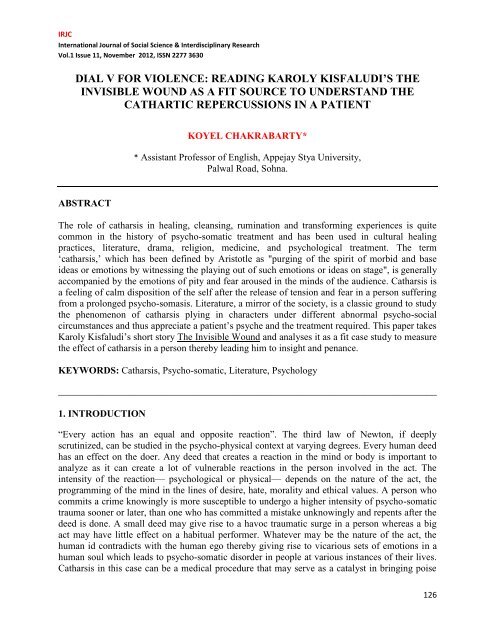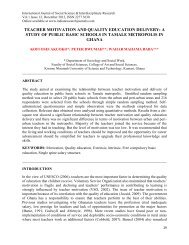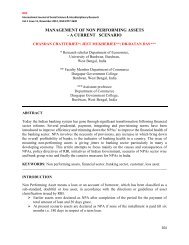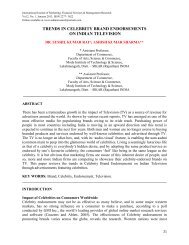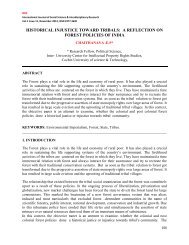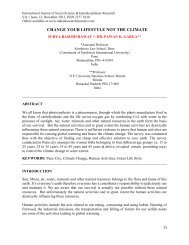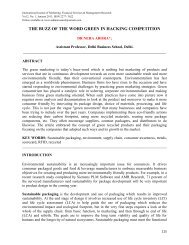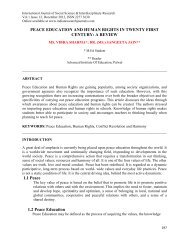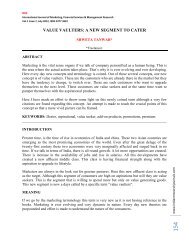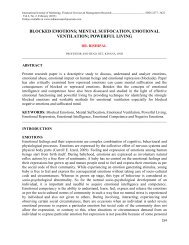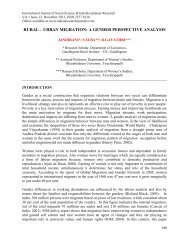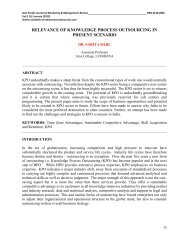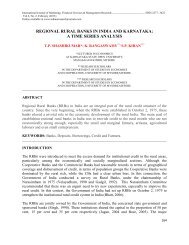dial v for violence: reading karoly kisfaludi's the invisible wound as a ...
dial v for violence: reading karoly kisfaludi's the invisible wound as a ...
dial v for violence: reading karoly kisfaludi's the invisible wound as a ...
You also want an ePaper? Increase the reach of your titles
YUMPU automatically turns print PDFs into web optimized ePapers that Google loves.
IRJC<br />
International Journal of Social Science & Interdisciplinary Research<br />
Vol.1 Issue 11, November 2012, ISSN 2277 3630<br />
DIAL V FOR VIOLENCE: READING KAROLY KISFALUDI’S THE<br />
INVISIBLE WOUND AS A FIT SOURCE TO UNDERSTAND THE<br />
CATHARTIC REPERCUSSIONS IN A PATIENT<br />
KOYEL CHAKRABARTY*<br />
* Assistant Professor of English, Appejay Stya University,<br />
Palwal Road, Sohna.<br />
ABSTRACT<br />
The role of catharsis in healing, cleansing, rumination and trans<strong>for</strong>ming experiences is quite<br />
common in <strong>the</strong> history of psycho-somatic treatment and h<strong>as</strong> been used in cultural healing<br />
practices, literature, drama, religion, medicine, and psychological treatment. The term<br />
„catharsis,‟ which h<strong>as</strong> been defined by Aristotle <strong>as</strong> "purging of <strong>the</strong> spirit of morbid and b<strong>as</strong>e<br />
ide<strong>as</strong> or emotions by witnessing <strong>the</strong> playing out of such emotions or ide<strong>as</strong> on stage", is generally<br />
accompanied by <strong>the</strong> emotions of pity and fear aroused in <strong>the</strong> minds of <strong>the</strong> audience. Catharsis is<br />
a feeling of calm disposition of <strong>the</strong> self after <strong>the</strong> rele<strong>as</strong>e of tension and fear in a person suffering<br />
from a prolonged psycho-som<strong>as</strong>is. Literature, a mirror of <strong>the</strong> society, is a cl<strong>as</strong>sic ground to study<br />
<strong>the</strong> phenomenon of catharsis plying in characters under different abnormal psycho-social<br />
circumstances and thus appreciate a patient‟s psyche and <strong>the</strong> treatment required. This paper takes<br />
Karoly Kisfaludi‟s short story The Invisible Wound and analyses it <strong>as</strong> a fit c<strong>as</strong>e study to me<strong>as</strong>ure<br />
<strong>the</strong> effect of catharsis in a person <strong>the</strong>reby leading him to insight and penance.<br />
KEYWORDS: Catharsis, Psycho-somatic, Literature, Psychology<br />
______________________________________________________________________________<br />
1. INTRODUCTION<br />
“Every action h<strong>as</strong> an equal and opposite reaction”. The third law of Newton, if deeply<br />
scrutinized, can be studied in <strong>the</strong> psycho-physical context at varying degrees. Every human deed<br />
h<strong>as</strong> an effect on <strong>the</strong> doer. Any deed that creates a reaction in <strong>the</strong> mind or body is important to<br />
analyze <strong>as</strong> it can create a lot of vulnerable reactions in <strong>the</strong> person involved in <strong>the</strong> act. The<br />
intensity of <strong>the</strong> reaction— psychological or physical— depends on <strong>the</strong> nature of <strong>the</strong> act, <strong>the</strong><br />
programming of <strong>the</strong> mind in <strong>the</strong> lines of desire, hate, morality and ethical values. A person who<br />
commits a crime knowingly is more susceptible to undergo a higher intensity of psycho-somatic<br />
trauma sooner or later, than one who h<strong>as</strong> committed a mistake unknowingly and repents after <strong>the</strong><br />
deed is done. A small deed may give rise to a havoc traumatic surge in a person where<strong>as</strong> a big<br />
act may have little effect on a habitual per<strong>for</strong>mer. Whatever may be <strong>the</strong> nature of <strong>the</strong> act, <strong>the</strong><br />
human id contradicts with <strong>the</strong> human ego <strong>the</strong>reby giving rise to vicarious sets of emotions in a<br />
human soul which leads to psycho-somatic disorder in people at various instances of <strong>the</strong>ir lives.<br />
Catharsis in this c<strong>as</strong>e can be a medical procedure that may serve <strong>as</strong> a catalyst in bringing poise<br />
126
IRJC<br />
International Journal of Social Science & Interdisciplinary Research<br />
Vol.1 Issue 11, November 2012, ISSN 2277 3630<br />
and calm of mind <strong>the</strong>reby rele<strong>as</strong>ing <strong>the</strong> accumulated heated feelings, tension and unrest paving<br />
<strong>the</strong> sufferer towards insight and realization.<br />
The role of catharsis in healing, cleansing, rumination and trans<strong>for</strong>ming experiences is quite<br />
common in <strong>the</strong> history of psycho-somatic treatment and h<strong>as</strong> been used in cultural healing<br />
practices, literature, drama, religion, medicine, and psychological treatment. The term<br />
„catharsis,‟ which h<strong>as</strong> been defined by Aristotle <strong>as</strong> "purging of <strong>the</strong> spirit of morbid and b<strong>as</strong>e<br />
ide<strong>as</strong> or emotions by witnessing <strong>the</strong> playing out of such emotions or ide<strong>as</strong> on stage" 1 is generally<br />
accompanied by <strong>the</strong> emotions of pity and fear aroused in <strong>the</strong> minds of <strong>the</strong> audience. Catharsis is<br />
a feeling of calm disposition of <strong>the</strong> self after <strong>the</strong> rele<strong>as</strong>e of tension and fear in a person suffering<br />
from a prolonged psycho-som<strong>as</strong>is. Breuer and Freud described catharsis <strong>as</strong> an involuntary,<br />
instinctive body process, <strong>for</strong> example crying. 2 Schultz and Schultz followed <strong>the</strong> psychodynamic<br />
tradition and defined catharsis <strong>as</strong> "<strong>the</strong> process of reducing or eliminating a complex by recalling<br />
it to conscious awareness and allowing it to be expressed" 3 The American Psychological<br />
Association also <strong>as</strong>sociates catharsis with <strong>the</strong> psychodynamic <strong>the</strong>ory and defines it <strong>as</strong> "<strong>the</strong><br />
discharge of affects connected to traumatic events that had previously been repressed by bringing<br />
<strong>the</strong>se events back into consciousness and re-experiencing <strong>the</strong>m" 4<br />
Literature, a mirror of <strong>the</strong> society, is a cl<strong>as</strong>sic ground to study <strong>the</strong> phenomenon of catharsis<br />
plying in characters under different abnormal psycho-social circumstances and thus paves a way<br />
to appreciate a patient‟s psyche and <strong>the</strong> treatment required. Scheff defines catharsis <strong>as</strong> <strong>the</strong> rele<strong>as</strong>e<br />
of any of <strong>the</strong> four b<strong>as</strong>ic emotions through physical reactions to stimulus. The repressed emotions<br />
like grief, anger, fear, and embarr<strong>as</strong>sment find physical manifestations through catharsis with <strong>the</strong><br />
outlet of <strong>the</strong> emotions like crying, laughter, cold chills and frisson respectively. Outcome<br />
me<strong>as</strong>ures <strong>as</strong>sociated with catharsis include a sense of control over <strong>the</strong> rele<strong>as</strong>e of emotion, a<br />
clarity of thought after rele<strong>as</strong>e, and a generally ple<strong>as</strong>ant sense of well-being during and after<br />
catharsis h<strong>as</strong> taken place. 5<br />
It is interesting that Literature talks about instances in lives of <strong>the</strong> characters very much <strong>as</strong> a<br />
representation of <strong>the</strong> reality. In fact, <strong>the</strong> psychological reactions in one‟s mind are thoroughly<br />
represented in literature in <strong>for</strong>m of <strong>dial</strong>ogues, actions or soliloquies. The characters portrayed in<br />
a literary piece often find similar projections in human beings in real life and this makes<br />
literature more acceptable and closer to <strong>the</strong> heart. Through literature c<strong>as</strong>es can be studied in<br />
comparison to reality and thus, it automatically becomes a potent source of study of<br />
psychological derivations. The situations that <strong>the</strong> characters face are interesting and can serve <strong>as</strong><br />
c<strong>as</strong>e studies to provide an insight into different psychological estimations <strong>as</strong> <strong>the</strong>y equally<br />
undergo <strong>the</strong> rele<strong>as</strong>e of emotions of pity, embarr<strong>as</strong>sment or fear through <strong>the</strong> emotions of crying,<br />
laughter, cold chills and frisson, and laughter respectively. 6 The idea of catharsis in medicine is<br />
similar to that of literature. It means 'purging', 'purification', although in a medical sense this<br />
implies a physical rele<strong>as</strong>e, <strong>for</strong> example, expectoration of <strong>the</strong> sputa implies healing of cold. 7 This<br />
paper takes Karoly Kisfaludi‟s short story The Invisible Wound and analyses it <strong>as</strong> a fit c<strong>as</strong>e study<br />
to me<strong>as</strong>ure <strong>the</strong> effect of catharsis in a person <strong>the</strong>reby leading him to insight and penance.<br />
Karoly Kisfaludi‟s short story, The Invisible Wound is a thriller that keeps one engrossed till its<br />
l<strong>as</strong>t sentence. The story is not only interesting <strong>for</strong> its plot but also <strong>for</strong> its style of presentation.<br />
The story is important <strong>for</strong> analysis <strong>as</strong> it highlights a very crucial <strong>as</strong>pect of catharsis that is<br />
127
IRJC<br />
International Journal of Social Science & Interdisciplinary Research<br />
Vol.1 Issue 11, November 2012, ISSN 2277 3630<br />
<strong>violence</strong>. We have already found in real life how a person undergoes a cathartic revelation<br />
through <strong>the</strong> feelings of crying, fear, laughter but we very interestingly find in this story how a<br />
person takes <strong>violence</strong> <strong>as</strong> a means of cathartic revelation. The story tells us of a gentleman who<br />
suffers from <strong>the</strong> pangs of an <strong>invisible</strong> <strong>wound</strong> on his hand and finds it impossible to survive with<br />
<strong>the</strong> pain. He visits <strong>the</strong> doctor once and again with <strong>the</strong> same problem and get <strong>the</strong> <strong>invisible</strong> <strong>wound</strong><br />
operated but <strong>the</strong> pain oscillates back within few weeks. Finally, we find him disclose <strong>the</strong> truth<br />
behind such a strange dise<strong>as</strong>e which is purely psychological and moral in nature.<br />
The plot of <strong>the</strong> story revolves around a patient whose name is not revealed. We only come to<br />
know that he is a man of noble disposition, educated and is wealthy enough to maintain a<br />
promising estate. The story starts in a doctor‟s clinic where this gentleman comes in, with his<br />
right hand tied in a sling, suffering from tremendous pain in his hand. The doctor who is a<br />
perfect gentleman and is endowed with professional ethics, refuses to operate his <strong>wound</strong> despite<br />
<strong>the</strong> <strong>for</strong>mer‟s request <strong>as</strong> he fails to detect any scar or mark of injury in <strong>the</strong> patient‟s hand that w<strong>as</strong><br />
causing him unbearable pain. The fact that <strong>the</strong> patient w<strong>as</strong> experiencing unbearable pain <strong>for</strong> an<br />
<strong>invisible</strong> <strong>wound</strong> makes <strong>the</strong> readers curious. He explains:<br />
“I haven‟t been able to sleep <strong>for</strong> a week. There is some trouble with my right<br />
hand. I cannot make out what it is. It may be cancer or some o<strong>the</strong>r terrible dise<strong>as</strong>e.<br />
At first it did not bo<strong>the</strong>r me much, but lately it began to burn. I have not had a<br />
moment‟s relief. It pains me terribly. The pain incre<strong>as</strong>es hourly becoming more<br />
and more agonizing and unbearable. I have come to town to consult you. If I have<br />
to bear it ano<strong>the</strong>r hour, I shall go mad. I want you to burn it out or cut it out. or do<br />
something with it” (1).<br />
It is interesting that <strong>the</strong> patient wants not just a cure <strong>for</strong> his <strong>wound</strong> but a considerable amount of<br />
blood loss from his hand; this he demands would bring him relief. His desperateness to create<br />
<strong>violence</strong> on his healthy hand is indeed a psychological repercussion of some hidden feelings that<br />
he tries to give vent to through such a violent action. Here fear and pain are elements that <strong>the</strong><br />
protagonist of <strong>the</strong> story expects, which can provide him with <strong>the</strong> cathartic relief. Despite several<br />
consultations with <strong>the</strong> doctor, <strong>the</strong> protagonist turns a deaf ear and insists on <strong>for</strong> an operation. The<br />
doctor finding him desperate operates his mysterious <strong>wound</strong> cutting out a chunk of flesh and a<br />
good amount of blood from his body.<br />
“The stranger took <strong>the</strong> operation stoically and w<strong>as</strong> helpful with his directions. His<br />
hand never even trembled and when <strong>the</strong> round spot had been carved out he sighed<br />
a sign of happy relief, <strong>as</strong> if a load had been taken of his shoulders” (5)<br />
It is important to analyse <strong>the</strong> reaction of <strong>the</strong> patient after <strong>the</strong> operation <strong>as</strong> we see him relieved not<br />
of pain only but of a load. This is where <strong>the</strong> psychological interventions are necessary to<br />
understand <strong>the</strong> psyche of <strong>the</strong> patient.<br />
““You don‟t feel any pain now?” <strong>as</strong>ked <strong>the</strong> surgeon.<br />
128
IRJC<br />
International Journal of Social Science & Interdisciplinary Research<br />
Vol.1 Issue 11, November 2012, ISSN 2277 3630<br />
“Not <strong>the</strong> le<strong>as</strong>t,” he said with a smile. “It is <strong>as</strong> if <strong>the</strong> pain had been cut off and <strong>the</strong> slight<br />
irritation caused by <strong>the</strong> cutting seems like a cool breeze after a hot spell. Just let <strong>the</strong> blood run. It<br />
soo<strong>the</strong>s me”” (6)<br />
Here <strong>the</strong> conversation between <strong>the</strong> doctor and <strong>the</strong> patient exposes certain <strong>as</strong>pects of <strong>the</strong> cathartic<br />
effect that <strong>the</strong> patient experiences. Here tears are replaced by blood. It is apt to mention <strong>the</strong><br />
hydraulic model of emotions and venting <strong>the</strong>ory in this c<strong>as</strong>e <strong>as</strong> blood is used <strong>as</strong> a hydraulic <strong>for</strong>ce<br />
that when given vent to brings peace, calm, rele<strong>as</strong>es tension and heat of body and mind.<br />
Generally, tears carry away <strong>the</strong> negativity of feelings in a cathartic moment and bring in insight.<br />
The hydraulic model of emotions uses <strong>the</strong> analogy of <strong>the</strong> fluid flowing through a system. The<br />
American Psychological Association opines that emotional distress, if not expressed, gets stored<br />
and can create pressure in <strong>the</strong> system, <strong>the</strong>re<strong>for</strong>e 'venting' emotions should decre<strong>as</strong>e tension and<br />
consequentially <strong>the</strong> negative psychological experience and symptoms. The greater <strong>the</strong> expression<br />
of negative emotions, <strong>the</strong> greater <strong>the</strong> relief should be. But in this c<strong>as</strong>e, tears are docile elements<br />
that cannot stop his tremendous burning sensation. He tells of a burning sensation that is cooled<br />
with <strong>the</strong> flow of blood. Here burning, <strong>as</strong> we come to know at <strong>the</strong> end of <strong>the</strong> story is<br />
psychological purgation. In religious perceptions rele<strong>as</strong>e of negative feelings are done with fire,<br />
water, sacrifice, w<strong>as</strong>hing etc. Here we find <strong>the</strong> protagonist sacrificing his blood and skin first and<br />
<strong>the</strong>n using heated charcoal to get relief. Heat of unrest and guilt that made him unstable could<br />
only be cooled by ano<strong>the</strong>r doze of <strong>violence</strong> on him so <strong>as</strong> to match <strong>the</strong> original <strong>violence</strong> that he<br />
had committed on his loving wife. The methods of cathartic rele<strong>as</strong>e that he adopts are thus<br />
medically, religiously, spiritually and psychometrically pliable.<br />
The protagonist experiences a hellish situation in his life after becoming skeptic towards his wife<br />
and kills her only on <strong>the</strong> b<strong>as</strong>is of false <strong>as</strong>sumption of infidelity. Like Browning‟s heroes, in his<br />
poems, this man is also a patient of obsessive disorder syndrome that takes a unique shape this<br />
time leading to murder and repentance. This becomes clearer when he returns to <strong>the</strong> doctor only<br />
after three weeks with a similar complaint of tremendous pain in his hand on <strong>the</strong> same place. He<br />
complains:<br />
“You didn‟t cut it deep enough,” he groaned. “The pain returned; it is even worse<br />
than be<strong>for</strong>e. I am almost done <strong>for</strong>. I didn‟t want to trouble you again, so I just bore<br />
it, but I cant bear it any longer. You must operate it again”(7).<br />
The doctor repeats <strong>the</strong> same process letting him some peace but this time he does not seem<br />
satisfied or much relieved. He <strong>as</strong>sures <strong>the</strong> doctor, “You needn‟t be surprised if I am back again in<br />
a month,” (7). This statement of his clears all suspicion about his supposed insanity. He is <strong>as</strong><br />
sane <strong>as</strong> any intelligent normal person, perhaps more than o<strong>the</strong>rs, only with <strong>the</strong> fault of hubris in<br />
him. He is a man of moral disposition and realizes that <strong>the</strong> <strong>invisible</strong> would is nothing but<br />
psychological outcome of his guilt and pain. However, <strong>the</strong> traumatic part is that he cannot get rid<br />
of it. He implicitly explains <strong>the</strong> doctor, “It is <strong>as</strong> sure <strong>the</strong>re is God in heaven,” and it is He who is<br />
just in giving him this pain. The moral or spiritual fervor of <strong>the</strong> story becomes clear. The original<br />
mystery unravels in <strong>the</strong> end when after one month and three weeks time, he writes a letter to <strong>the</strong><br />
doctor unfolding his heart thus, making clear of all his agonies.<br />
129
IRJC<br />
International Journal of Social Science & Interdisciplinary Research<br />
Vol.1 Issue 11, November 2012, ISSN 2277 3630<br />
“Dear doctor: I do not want to leave you in any doubt <strong>as</strong> to <strong>the</strong> origin of my<br />
trouble, and do not care to carry <strong>the</strong> secret of it into my grave, or perhaps<br />
elsewhere. I wish to acquaint you with <strong>the</strong> history of my terrible illness. It h<strong>as</strong><br />
returned three times now and do not intend to go on struggling against it any<br />
longer. I am only able to write this letter by placing a burning coal on <strong>the</strong> spot <strong>as</strong><br />
an antidote against <strong>the</strong> hellish flames that burn it within (8).<br />
The language of <strong>the</strong> letter is quite significant <strong>as</strong> it not only reveals <strong>the</strong> story behind his terrible<br />
illness but also admits that he is undergoing a hellish experience. He feels <strong>the</strong> fire of hell burning<br />
in <strong>the</strong> <strong>wound</strong> which actually represents his mind full of culpability. It is interesting that <strong>the</strong><br />
dise<strong>as</strong>e which a reader or a doctor may feel strange or mysterious is actually terrible <strong>for</strong> him. He<br />
confesses of being a murderer himself and describes his innocent wife very much loving and<br />
beautiful in dr<strong>as</strong>tic contr<strong>as</strong>t to himself. He calls himself a fool who had tried to find unhappiness<br />
in his happy life and had made it really hellish. “Man is foolish enough to seek misery in <strong>the</strong><br />
midst of his greatest happiness” (8). The psychological disorder is very much prominent when he<br />
describes him <strong>as</strong> cynic and disbeliever. “The poison had taken effect in my soul and had eaten<br />
itself through every vein of my body” (10). Here <strong>the</strong> poison is of disbelief which had<br />
overshadowed his mind about his wife. The protagonist actually felt unsecured internally about<br />
his nuptial relationship and thus suspected pretence in his innocent wife. He strangles his wife<br />
out of rage and mistrust, disregarding her love <strong>for</strong> him and takes her <strong>as</strong> an imposter and an<br />
infidel lady. Later on, when he finds out his fault and her innocence, he becomes unstable.<br />
Anagnorisis upturns his world and he finds himself at <strong>the</strong> pit of <strong>the</strong> dungeon horrible fighting<br />
with his negative self that had <strong>for</strong>ced him to commit such a blunder. He realizes <strong>the</strong> cause of his<br />
pain and deliberates very clearly in his letter that while she died, “One drop of blood oozed<br />
through her lips and dropped on my hand—you know <strong>the</strong> spot.” Fur<strong>the</strong>r in his confession he<br />
acknowledges his sin and decides to commit suicide, which is again a sin if considered from <strong>the</strong><br />
Christian view point.<br />
“Exactly one week after <strong>the</strong> burial a stinging pain visited <strong>the</strong> spot on my hand<br />
where <strong>the</strong> drop of blood fell on that terrible night. The rest you know. I know it is<br />
nothing but auto-suggestion, but I cannot rid myself out of it. I am going to join<br />
her and will try to obtain her pardon” (12).<br />
The story is a cl<strong>as</strong>sic example of how a psychologically sick person takes refuge of <strong>violence</strong> and<br />
death to get his tension rele<strong>as</strong>ed. The protagonist, who is an egoist and know-all of his state of<br />
mind, burns in anguish unable to get his crime nullified. The psychological purgation that starts<br />
after <strong>the</strong> commitment of murder builds in <strong>the</strong> heat till <strong>the</strong> plot reaches <strong>the</strong> climax where we<br />
finally get to know about <strong>the</strong> <strong>wound</strong>. The rising action arouses pity and fear in <strong>the</strong> readers and<br />
<strong>the</strong>y too get a rele<strong>as</strong>e of tension after <strong>the</strong> mystery is unveiled. The pain h<strong>as</strong> given him insight and<br />
<strong>violence</strong>—bloodshed or death, whatever it may be— is <strong>the</strong> path that he takes <strong>for</strong> obtaining relief.<br />
The Invisible Wound is a fit c<strong>as</strong>e <strong>for</strong> analyzing <strong>violence</strong> <strong>as</strong> a means of cathartic relief which can<br />
give better understanding of a patient psychology suffering from <strong>wound</strong>, pain and guilty<br />
consciousness. It also leads us to a safe conclusion that <strong>the</strong>re is a vivid connection between <strong>the</strong><br />
psyche and <strong>the</strong> some help can be rendered if <strong>the</strong> violent technique is applied with me<strong>as</strong>ure and<br />
130
IRJC<br />
International Journal of Social Science & Interdisciplinary Research<br />
Vol.1 Issue 11, November 2012, ISSN 2277 3630<br />
condition differing from c<strong>as</strong>e to c<strong>as</strong>e with certain precautions. Had <strong>the</strong> protagonist been exposed<br />
to a counselor or police and received his punishment through o<strong>the</strong>r means, <strong>the</strong>n he may would<br />
have been relieved differently. But <strong>the</strong> act of suppression and superiority complex holds him<br />
from doing so and he suffers terribly till he confesses his crime through a letter to <strong>the</strong> doctor. In<br />
fact, in a way, <strong>the</strong> writing of <strong>the</strong> confession letter is <strong>the</strong> greatest cathartic relief that he<br />
experiences and attains <strong>the</strong> insight which is nothing but saintly. Here like any tragic hero, he<br />
looks like an inverted saint who after realizing <strong>the</strong> crux of life embraces hardship and penance.<br />
Jemmer argues that traumatic experience, if repeatedly relived in catharsis, can be relearned and<br />
become harmful. 8 This is what we experience in <strong>the</strong> story. Excessive rele<strong>as</strong>e of <strong>the</strong> cathartic<br />
emotion, continuous exposure to physical <strong>violence</strong> and logically rationalizing each effect in mind<br />
that linked to a same cause, that is, <strong>the</strong> murder which he had committed, had incre<strong>as</strong>ed <strong>the</strong><br />
protagonist‟s tendency to delve deep in himself and apprehend <strong>the</strong> deep-seated guilt which thus<br />
took an exaggerated shape. This might have <strong>for</strong>ced him to develop a suicidal motive which he<br />
refers to commit in <strong>the</strong> end.<br />
Even though <strong>the</strong> method of catharsis is not used so frequently to cure a patient in present<br />
centuries, it still can be used <strong>for</strong> understanding <strong>the</strong> problem of <strong>the</strong> patient and thus suggest<br />
fur<strong>the</strong>r advanced cure. Catharsis, which is very much linked with literature, h<strong>as</strong> a special role to<br />
play in society <strong>as</strong> it itself becomes a means or catalyst <strong>for</strong> cathartic rele<strong>as</strong>e in <strong>the</strong> readers through<br />
laughter, sorrow, pains and tears. With <strong>the</strong> flow of <strong>the</strong> emotions of pity and fear, a reader who<br />
w<strong>as</strong> <strong>as</strong>sociating himself with <strong>the</strong> character gets purged off and starts his life afresh. He gains an<br />
insight just <strong>as</strong> a character gains an insight at <strong>the</strong> end of any literary text. For medical practitioners<br />
literature serves <strong>as</strong> a fit resource to add insight into different characters and help <strong>the</strong>m use<br />
catharsis or any o<strong>the</strong>r mode of counseling accordingly in real life. This paper by analyzing<br />
Karoly Kisfaludi‟s short story The Invisible Wound tries to decipher <strong>the</strong> means and modes of<br />
cathartic rele<strong>as</strong>e in a patient and brings light to <strong>the</strong> fact how literature can serve <strong>as</strong> potent<br />
resource <strong>for</strong> examining patients in real lives.<br />
References<br />
1. Aristotle. (2001). The B<strong>as</strong>ic Works of Aristotle. McKeon, R. (Ed.). New York: Modern Library.<br />
2. Breuer, J., Freud, S. (1974). Studies on hysteria. Harmondsworth: Penguin Books.<br />
3. Schultz, D. P., Schultz, S. E. (2004). A history of modern psychology (8th ed.). Belmont, CA:<br />
Wadsworth/Thompson.<br />
4. American Psychological Association.(2007). Dictionary of Psychology. W<strong>as</strong>hington, DC: Author.<br />
Print.<br />
5. Scheff, T.J. (2001). Catharsis in healing, ritual, and drama. Lincoln, NE: iUniverse.com.<br />
6. Lerner, Janet M. 1985. “Structured Improvisation Counseling: A Study Of The Use Of Ritual And<br />
Drama In Homogeneous And Multicultural Settings.” The First National Symposium on Doctoral<br />
Research and Social Work Practice The Ohio State University: 1985:6<br />
7. Powell, Esta. Catharsis in Psychology and Beyond: A Historic Overview.<br />
Refer: http://primal-page.com/cathar.htm<br />
8. Jemmer, P. (2006). Abreaction - catharsis: Stirring dull roots with spring rain. European Journal of<br />
Clinical Hypnosis, 7(1), 26-36. Print.<br />
9. Kisfaludi, Karoly. The Invisible Wound http://ravenessence.tripod.com/<br />
131


